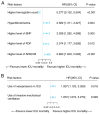Risk factors and predictive model for mortality in patients undergoing allogeneic hematopoietic stem cell transplantation admitted to the intensive care unit
- PMID: 38476903
- PMCID: PMC10928819
- DOI: 10.3892/etm.2024.12457
Risk factors and predictive model for mortality in patients undergoing allogeneic hematopoietic stem cell transplantation admitted to the intensive care unit
Abstract
Hematological malignant tumors represent a group of major diseases carrying a substantial risk to the lives of affected patients. Risk factors for mortality in critically ill patients have garnered substantial attention in recent research endeavors. The present research aimed to identify factors predicting intensive care unit (ICU) mortality in patients undergoing allogeneic hematopoietic stem cell transplantation (allo-HSCT). Furthermore, the present study analyzed and compared the mortality rate between patients undergoing haploidentical hematopoietic stem cell transplantation (Haplo-SCT) and those undergoing identical sibling donor (ISD) transplantation. A total of 108 patients were included in the present research, 83 (76.9%) of whom underwent Haplo-SCT. ICU mortality was reported in 58 (53.7%) patients, with the values of 55.4 and 48.0% associated with Haplo-SCT and ISD, respectively (P=0.514). The mortality rate of patients undergoing Haplo-SCT was comparable to that of patients undergoing ISD transplantation. The present study found that reduced hemoglobin, elevated total bilirubin, elevated brain natriuretic peptide, elevated fibrinogen degradation products, need for vasoactive drugs at ICU admission, need for invasive mechanical ventilation and elevated APACHE II scores were independent risk factors for ICU mortality. Among patients presenting with 5-7 risk factors, the ICU mortality reached 100%, significantly exceeding that of other patients. The present research revealed that ICU mortality rates remain elevated among patients who underwent allo-HSCT, especially those presenting multiple risk factors. However, the outcome of patients undergoing Haplo-SCT were comparable to those of patients undergoing ISD transplants.
Keywords: haploidentical hematopoietic stem cell transplantation; identical sibling donor transplantation; intensive care unit; mortality.
Copyright: © 2024 Wu et al.
Conflict of interest statement
The authors declare that they have no competing interests.
Figures



Similar articles
-
Peritransplantation Glucocorticoid Haploidentical Stem Cell Transplantation Is a Promising Strategy for AML Patients With High Leukemic Burden: Comparison With Transplantations Using Other Donor Types.Transplant Cell Ther. 2023 Apr;29(4):273.e1-273.e9. doi: 10.1016/j.jtct.2023.01.005. Epub 2023 Jan 12. Transplant Cell Ther. 2023. PMID: 36641032
-
Comparison of outcomes in hematological malignancies treated with haploidentical or HLA-identical sibling hematopoietic stem cell transplantation following myeloablative conditioning: A meta-analysis.PLoS One. 2018 Jan 30;13(1):e0191955. doi: 10.1371/journal.pone.0191955. eCollection 2018. PLoS One. 2018. PMID: 29381772 Free PMC article.
-
Unmanipulated haplo-identical donor transplantation compared with identical sibling donor had better anti-leukemia effect for refractory/relapsed acute myeloid leukemia not in remission status.Ann Hematol. 2020 Dec;99(12):2911-2925. doi: 10.1007/s00277-020-04283-0. Epub 2020 Oct 1. Ann Hematol. 2020. PMID: 33000361
-
Haploidentical stem cell transplantation vs matched unrelated donor transplantation in adults with hematologic malignancies: a systematic review and meta-analysis.Hematology. 2020 Dec;25(1):356-365. doi: 10.1080/16078454.2020.1831292. Hematology. 2020. PMID: 33054609
-
Haploidentical versus matched donor stem cell transplantation for patients with hematological malignancies: a systemic review and meta-analysis.Bone Marrow Transplant. 2019 Jan;54(1):99-122. doi: 10.1038/s41409-018-0239-9. Epub 2018 Jul 9. Bone Marrow Transplant. 2019. PMID: 29988061
Cited by
-
Optimization of diagnosis and treatment of hematological diseases via artificial intelligence.Front Med (Lausanne). 2024 Nov 7;11:1487234. doi: 10.3389/fmed.2024.1487234. eCollection 2024. Front Med (Lausanne). 2024. PMID: 39574909 Free PMC article. Review.
References
-
- Sant M, Minicozzi P, Mounier M, Anderson LA, Brenner H, Holleczek B, Marcos-Gragera R, Maynadié M, Monnereau A, Osca-Gelis G, et al. Survival for haematological malignancies in Europe between 1997 and 2008 by region and age: Results of EUROCARE-5, a population-based study. Lancet Oncol. 2014;15:931–942. doi: 10.1016/S1470-2045(14)70282-7. - DOI - PubMed
LinkOut - more resources
Full Text Sources
